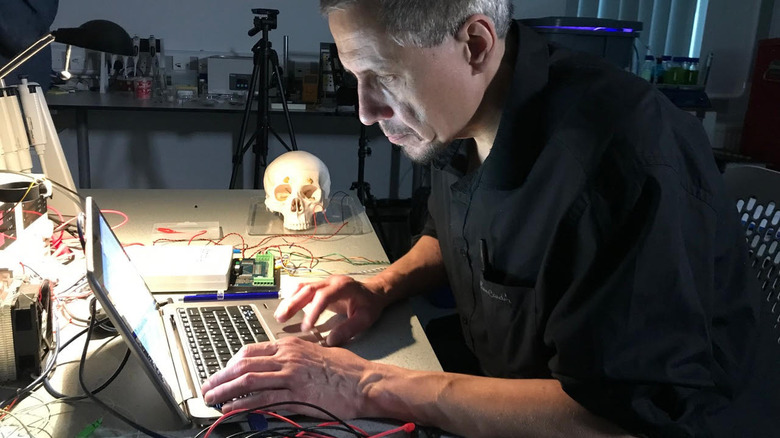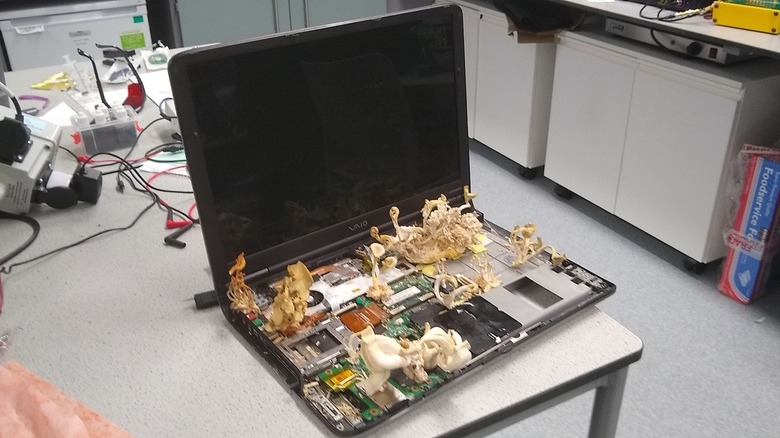This Mushroom PC Sounds Like Something Out Of The Last Of Us
When you think about it, hit video game and TV series "The Last Of Us" has one of the most disturbing concepts in the history of fiction. Cordyceps is a real-life fungus that infects insects like ants, turns them into zombies, and makes them compulsively climb to high spots so the spores spread further when the fungi bursts from the top of the ant's head.
In "The Last of Us," that fungi has adapted and can infect humans. As a result, society collapses, as you may expect it to do when a large chunk of the population becomes a revolting mass of fungus and misery. 20 years after the fungus took hold, the title characters — Joel and Ellie — are among those who escaped the mushroom plague, and have to navigate through a post-apocalyptic world full of cordyceps zombies in service of finding a cure to the infection.
Thankfully, cordyceps are not capable of attack humans outside of fictional media, and our immune system is pretty well equipped to handle fungus anyway — but the concept is rooted in reality. Things like mushrooms can mimic human brain activity, and scientists in the U.K. have also worked out that fungus can mimic certain computer functions. Some have actually used various kinds of functional fungus to replace computer parts and hardware.
The concept works, and the potential it has for technology is immense. It isn't just mushrooms either: the same scientists have created mold-powered robots in the past, too. In the future, organic computing could be an advancement similar to AI, VR, brain implants, or like many of the various futuristic and innovative discoveries made in recent years.
A fungus has replaced some common computer parts
Researchers at the Bristol-based University of the West of England have worked out a way to replace parts of a PC with mushrooms. Fungi contains things called "mycelium," which are miniscule, thread-sized filaments primarily used to grow and expand.
These mycelium have been known to connect extremely large fungal growths, and it turns out they can connect bits of hardware inside of a computer as well. The conductive filaments can transmit electrical signals, receive them, and retain memory. Because of this, they've also been used to replicate components like a computer's processor and RAM.
The biological computing researchers have used various types of mushrooms and molds for a number of computing purposes. They also claim there are some big advantages to using fungus in place of traditional silicon. The mushrooms have a larger fault tolerance than silicon counterparts, as they are capable of generating themselves. The fact it is a living, breathing, and growing organism also means it is easier to reconfigure than a traditional machine. Arguably, the most promising development centers on the way the fungus works.
It's capable of behaving like human brain tissue, and uses "spiking" as a means of storing memory. The presence or lack of a spike can sort-of act like the binary code computers use to function. That being said, brain and fungus cells are capable of being far more dynamic than a standard computer. Scientists are already using brain cells for computing research, and some believe human grey matter will be key to creating the next generation of supercomputers. Fungi could produce a similar effect.
Don't toss your motherboard just yet
While fungus-based computing is certainly innovative — and could be the basis of some huge advancements in the future — it's still in its very early stages. It's nowhere near as powerful as good old-fashioned silicon as things stand. It's also the product of research being conducted in a university lab, so you can't exactly head to Best Buy and pick up a portobello processor or a morel motherboard.
Speaking to Popular Science, Professor Andrew Adamatzky, who leads the team that is looking into mushroom-based computing, says: "Right now it's just feasibility studies. We're just demonstrating that it's possible to implement computation, and it's possible to implement basic logical circuits and basic electronic circuits with mycelium. In the future, we can grow more advanced mycelium computers and control devices."
As things stand, the organic components may not be anywhere near as quick or effective as modern components, but the potential is certainly there. While the fungi involved aren't likely to be taking over brains, "The Last of Us" style, they could still be doing some heavy lifting inside a human skull. Adamatzky is attempting to make a "brain" from fungus, using several kinds of fungi and hemp shavings as a framework.


